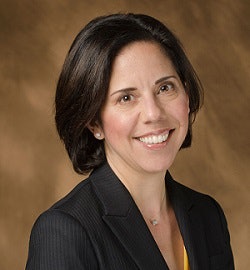A new report this week from the American Council on Education affirms what those familiar with minority serving institutions (MSIs) know to be true of the institutions’ significant role in bolstering the economic mobility of low-income students.
Using newly released federal data, ACE’s report, “Minority Serving Institutions as Engines of Upward Mobility,” finds that students who attend MSIs move up the economic ladder at two to three times the rate of students who attend non-MSIs – despite the limited financial resources the institutions receive compared to non-MSIs.
 Dr. Lorelle L. Espinosa
Dr. Lorelle L. Espinosa“These institutions are meeting students where they are, and they’re doing it with a great intentionality both to educate students in the way that they need given their life circumstances, and also propelling students up the income ladder in terms of where students end up later,” said Dr. Lorelle L. Espinosa, lead author of the report and assistant vice president for ACE’s Center for Policy Research and Strategy.
In a “first-of-its-kind” analysis, researchers analyzed Stanford University professor Dr. Raj Chetty’s Equality of Opportunity Project, which focused, in part, on higher education’s impact on intergenerational mobility. The new report examined IPEDS data and data from more than 359 MSIs – with few exclusions due to smaller sample size or limitations – in IPEDS enrollment by race data for some institutions.
MSIs include historically Black colleges and universities (HBCUs); tribal colleges and universities (TCUs); Hispanic-serving institutions (HSIs); Alaska Native and Native Hawaiian-serving institutions (ANNH); Asian American and Native American-Pacific Islander-serving institutions (AANAPISI); predominantly Black institutions (PBIs); and Native American-Serving, nontribal institutions (NASNTI).
To measure upward mobility, ACE researchers identified the income information of individuals at two time periods — the income of a student’s parents at the time of the student’s first postsecondary enrollment, and then the income of the student themselves at age 30. Income data was reported in terms of quintiles, the report said, and institutions were given MSI or non-MSI designations based on IPEDS data.
Researchers’ findings show that across all MSI types, four-year MSIs propel more students from the lowest income quintile to the top income quintile than four-year non-MSIs. HSIs’ mobility rate is noteworthy, as these institutions propelled their students into the highest income quintile at three times the rate of non-MSIs (4.3 percent compared to 1.5 percent, respectively).
AANAPISIs, PBIs and HBCUs had mobility rates two times that of non-MSIs at 3.3, 3.5 and 2.8 percent, respectively.
Additional findings reveal that one in five students enrolled at four-year HSIs and nearly one in four students enrolled at four-year PBIs and HBCUs were from families in the lowest income quintile, which is more than three times that of non-MSIs.
Significantly, these three MSI types enrolled between 45 and 53 percent of first-generation college students, the report said.
Two-year MSIs had mobility rates that were also higher than non-MSI two-year institutions.
Insight into MSIs’ “extended mobility” rate — the rate of students who move from the bottom two income quintiles to the top two income quintiles — indicates that these rates are higher at both two- and four-year MSIs than at non-MSIs. In particular, HSIs, PBIs and HBCUs had extended mobility rates double that of non-MSIs’ 9.4 percent extended mobility rate.
The report cites numerous MSIs with high extended mobility rates. Institutions include CUNY Lehman College (35.5 percent), Texas A&M International University (34.1 percent), CUNY Baruch College (36.6 percent), CUNY City College (32.9 percent), Alcorn State University (27.4 percent) and Southern University and A&M College (24.9 percent), among others.
Noting that the whole of higher education — MSIs and non-MSIs — are making a “considerable contribution” to the upward mobility of Americans who begin in the bottom two quintiles of family income, the report added that it is important for policymakers and educators to “strengthen this value proposition by ensuring that those institutions in the best position to educate low-income students receive the resources they need.”
The nation’s 700 MSIs collectively enrolled 4.8 million students in 2015, accounting for 28 percent of all undergraduates in U.S. higher education, the report said. The number of MSIs is expected to grow in the next few years.
“Nearly all of the projected postsecondary enrollment growth through 2025 will be through increased enrollment by racial and ethnic minority students, with minority students comprising nearly half of all postsecondary students within the next decade,” the report added.
Espinosa said students are increasingly attending MSIs for many reasons. MSIs “meet students where they are, they have more flexible schedules, many of them are community colleges, they are in neighborhoods where students live … they’re more available, they’re more accessible, they are more intentional about the ways they serve students,” she said.
HBCUs and TCUs, particularly, give students a sense of belonging in terms of embracing students’ cultural backgrounds, Espinosa added.
ACE’s report makes the case for policymakers to invest more in MSIs and encourages higher education institutions as a whole to examine, learn and share the policies and practices employed by top-performing MSIs to better support students.
“One sees a strong case here for increased investment in institutions that are meeting students where they are, and making good on the value of higher education for individuals, families and communities,” the report concluded.
Tiffany Pennamon can be reached at [email protected]. You can follow her on Twitter @tiffanypennamon.



















